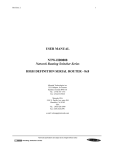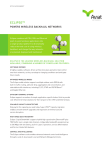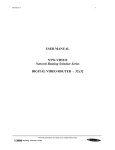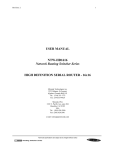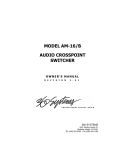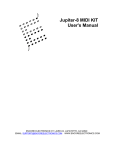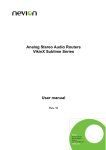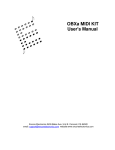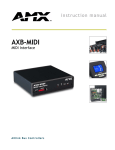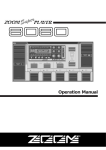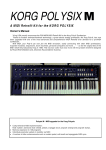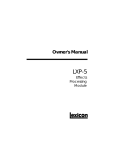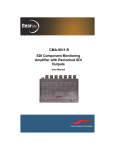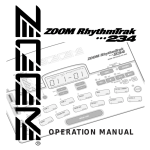Download USER MANUAL NTW-VD1602 Network Routing Switcher - AV-iQ
Transcript
Revision: 0 1 USER MANUAL NTW-VD1602 Network Routing Switcher Series DIGITAL VIDEO ROUTER - 16x2 Miranda Technologies inc. 2323 Halpern, St-Laurent (Quebec) Canada H4S 1S3 Tel.: (514) 333-1772 Fax: (514)333-9828 Miranda USA 1101 N. Pacific Ave, suite 204 Glendale, CA 91202 USA Tel.: (305) 820-2990 Fax: (305) 820-2991 e-mail: [email protected] Technical specifications are subject to be changed without notice Revision: 0 2 Index 0. Revision history 3 1. General 4 1.1. 1.2. Specifications Connection drawing 2. Power connection 5 3. Connecting the NTW-VD1602 to your PC 5 3.1. 3.2. 3.3. Selection of router address Pin-out of RS-232 connector Maximum cable length 4. MIDI connection 4.1. 4.2. 4.3. 4.4. 4.5. Several routers in one system Connecting control panels Pin-out and cable type MIDI bus structure Maximum distance between MIDI devices 5. Router configuration 5.1. 5.2. 5.3. Router address Router extension mode Vertical interval trigger 6. Connecting video signals to the NTW-VD1602 8 7. Input extension 9 8. Control and connection of Network systems, interface protocol 8.1. 8.1.1. 8.1.2. 8.1.3. 8.1.4. 8.2. 8.2.1. 8.2.2. 8.3. 8.4. 8.5. 8.5.1. 8.5.2. 8.5.3. Important notes regarding the Network Control Protocol Binary Code Acknowledge / Echo RS-422 Matrixes Timeout Basic principles Example: A single unit with no MIDI connected Example: Several units connected by MIDI RS232 MIDI Commands Audio crosspoint set Video crosspoint set Crosspoint status request 4 4 5 5 5 6 6 6 6 6 7 7 7 8 8 General Environmental Requirements for Network Electronics Equipment Technical specifications are subject to be changed without notice 10 10 10 10 10 10 10 11 11 11 11 12 12 12 12 13 Revision: 0 3 0. Revision history Current revision of this document is the uppermost in the table below. Revision Replaces Date 0 - 10/10/00 Change Description Initial Revision Technical specifications are subject to be changed without notice Revision: 0 4 1. General The NTW-VD1602 is a 16x2 serial digital video router with vertical interval switching and integrated control panel. This state of the art router provides maximum quality with a data rate of up to 360Mbit/s and automatic cable equalizing. The NTW-VD1602 offers the possibility to expand the router in the input direction up to 64x2. The NTW-VD1602 is well suited for all demanding routing tasks in digital studio and broadcast environments. The built-in RS-232 interface allows the user to control the router via the i-Control PC software with many operational features. The control bus allows linking the unit to the NTW-AD1602 or NTW-A1602 audio router thus creating a 16x2 AFV router. One or several remote control panels (NTW16-ProX-Y, NTW-16-ProS) can control the NTW-VD1602 as well. The control panel provides buttons for selection of inputs and 4 function keys with following functions: • • • • 1.1. 1.2. OUTPUT 1 OUTPUT 2 AUDIO / VIDEO ENABLE Assigns input buttons to output 1 Assigns input buttons to output 2 Enables Audio, Video or AFV Enables panel Specifications Data rate NRZ: VIT input: Number of inputs: Equalization: Number of outputs: Auxiliary inputs: Auxiliary output: Impedance: Return-loss in/out: Signal level: Rise/fall time: Connector: AC power: DC power: Dimensions: 143Mbit/s - 360Mbit/s Comp. Video 1Vpp, 300mV sync, 75 ohms 16 terminated Automatic up to 300m ( Belden 8281 ) 2 4 for router extension 1 for router extension > 75 ohms > 18dB (10MHz – 270MHz) 800mV fixed on 75Ohm load typ. 750ps BNC External power supply 100 - 260 VAC ±5V, connector DB9 male 483 x 44 x 45 mm (19”, 1RU) Connection drawing Configuration switch Video input section MIDI bus Power connector Video outputs Vertical Interval Trigger RS-232 port Technical specifications are subject to be changed without notice Extension Extension Router Output Revision: 0 5 2. Power connection Do not connect mains to the desk top power supply before connecting the power supply to the router. Connect the DB9 female connector from the desk top power supply to the main unit. Tighten the screws to assure a proper contact. To connect mains to the desk top power supply you need a mains cord with IEC 320 connector. NTW-VD1602 uses the desk top power model AC-10-84-10-005 (±5V / 10W). If an external power supply is used the NTW-VD1602 router requires ±5V DC with a minimum current of 600mA. The following pin-out is used on the DB9 male power connector: Pin 1 Pin 2 Pin 6 0V +5V -5V 3. Connecting the NTW-VD1602 to your PC For connection to a PC with Miranda’s i-Control control software the RS-232 interface is used. The RS-232 port on all Network devices uses the standard DCE pin-out, see pin-out table under 4.3. A standard modem cable can be used for connecting the router to the PCs serial port. 3.1. Selection of router address The router address depends on the system configuration the router is going to work with. See chapter 5 for more information. All routers are delivered with default address 0. A router addressed to 0 can be controlled from the i-Control software with address 0. i-Control offers the control of up to 16 different routers or combinations of routers. 3.2. Pin-out of RS-232 connector The DB9 female connector for the RS-232 port has the following pin-out: Pin 2 Pin 3 Pin 5 Tx Rx GND 3.3. Maximum cable length The maximum cable length for a RS-232 connection is per definition 15m. Longer distances can be installed depending on the environmental conditions of the installation site. It is up to the installer / user to secure a proper installation of the RS232 connection. Technical specifications are subject to be changed without notice Revision: 0 6 4. MIDI connection Via the MIDI bus system several routers and control panels can be interconnected. The standard MIDI interface is used on all Network MIDI control ports. For interconnection between the devices a standard MIDI cable with 5pin DIN connector on both ends is used. The Network MIDI bus system allows connection of up to 16 routers with different addresses on the same bus. Routers which are defined to work married e. g. 2 routers as Audio follow Video or 3 routers as RGB (YUV) must be set on the same address. Control panels dedicated to work with a specific router must have the same address as the router. Several panels can work together with one specific router. Up to 16 single routers or combinations of routers can be controlled from one I-Control control screen. The MIDI bus system and all RS-232 ports interchange the system status. 4.1. Several routers in one system The Network MIDI bus system allows the interconnection of up to 16 routers with different addresses in one system. A combination of routers working married counts as one address. This might for example be 1 audio router + 1 video router working as an audio follow video system or 3 video routers working as a RGB (YUV) system. The routers in such a constellation have to have the same address. 4.2. Connecting control panels To get a control panel working with a specific router, give the control panel the same address as the router. Several panels can be addressed to the same router. The X-Y panels can control 2 layers with breakaway function. If it is necessary to control more layers with breakaway an additional panel must be used. Panels can also be connected to a router via the RS232 interface. Please refer to your control panel manual for installation. 4.3. Pin-out and cable type The pin-out of all Network MIDI ports follows the standard MIDI specification. A 1 to 1 cable with 5pin DIN connector is used. The following pin-out is used: 1 - n.c. 1 - n.c. 2 - shield # # # # # # # # # # # # # # # # # # # # # # 2 - shield 3 - n.c. 3 - n.c. 4 - data - - - - - - - - - - - - - - - - - - - - - - - - - - - - - 4 - data data lines must 5 - data - - - - - - - - - - - - - - - - - - - - - - - - - - - - - 5 - data be twisted pair The standard MIDI specification recommends the use of shielded twisted pair cable types for interconnection between the units. 4.4. MIDI bus structure The Network MIDI bus structure follows the standard MIDI bus definition. The Network MIDI bus is defined as a closed chain of units. This means that the MIDI OUT of the last unit must be connected to the MIDI IN of the first unit in the MIDI chain. To avoid problems with the control of Network units the installer/user has to assure that the bus structure is installed according to this definition. The total number of MIDI devices in a MIDI chain is limited to 50. Technical specifications are subject to be changed without notice Revision: 0 7 4.5. Maximum distance between MIDI devices The standard MIDI definition allows a maximum cable length of 250 meters between two devices. Longer distances can be made with MIDI repeater units. To avoid grounding problems all Network MIDI ports have opto-coupled inputs. 5. Router configuration 5.1. Router address Switch 1 - 4 on the configuration switch set the router’s address for communication with the i-Control software and other units in the MIDI bus system. The i-Control control screen and the panels on the MIDI bus dedicated to operate with the router have to have the same address. If several routers are combined to form an Audio Follow Video, RGB or similar system, these routers have to have the same address. The addresses can be switched according to the following pattern: * means switch down means switch up Default address is 0. Switch 1 2 3 4 * * * * * * * * * * * * * * * * * * * * * * * * * * * * * * * * Address 0 1 2 3 4 5 6 7 8 9 10 11 12 13 14 15 Technical specifications are subject to be changed without notice Revision: 0 8 5.2. Router extension mode Switch 5, 6 and 7 on the configuration switch set the router’s input offset in systems with 2 or more NTW-VD1602. You can build systems up to 64x2. The chosen input offset defines on which input range each NTW-VD1602 works on. The offset can be switched according to the following pattern: * means switch down means switch up Switch 5 6 7 Offset - * * * * 0 16 32 48 Switch 5 is always in position down. Default is offset 0. 5.3. Vertical interval trigger Switch 8 on the configuration switch enables or disables the VIT sensing on VIT input. If VIT switching is enabled but a proper signal is missing, the router will automatically switch without VIT. The VIT can be switched according to the following pattern: * means switch down means switch up Switch 8 VIT * disabled enabled Default is VIT enabled. 6. Connecting video signals to the NTW-VD1602 The NTW-VD1602 router offers standard 75 ohms BNC connectors for digital video in- and outputs. All digital video inputs are terminated with 75 ohms. Technical specifications are subject to be changed without notice Revision: 0 9 7. Input extension NTW-VD1602 allows input extension up to 64x2. Please connect the routers as shown below. A 4x1 extension router is used to collect the signal from several units. Please refer to chapter 5.2 regarding input offset. Technical specifications are subject to be changed without notice Revision: 0 10 8. Control and connection of Network systems, interface protocol 8.1. Important notes regarding the Network Control Protocol 8.1.1. Binary Code The strings shown on the next pages are in binary coded format. Please be aware of the fact that any terminal program you may use to control a Network unit from a PC must be able to generate hexadecimal characters. ASCII characters will not be accepted. 8.1.2. Acknowledge / Echo A matrix will reply on a crosspoint set command with an ECHO. In the case where a crosspoint is already set no ECHO will be sent. If the matrix is part of a MIDI system two types of reply will be sent. Immediately after receiving the crosspoint set command the ECHO will be sent. The matrix will then wait for the command to pass the MIDI bus system. After receiving the command from the MIDI bus system the matrix will send the command as an ACKNOWLEDGE. 8.1.3. RS-422 Matrixes RS-422 Data Routers do not accept distribution of an input signal to several outputs. An input signal can only be routed to one single output. The Firmware of our RS-422 routers takes care of these limitations. If an input (Source) is already connected to a particular output (Destination) any connection of this input to another output will disconnect the previous connection. The router will in this case send the following message for the disconnected output: Output connected to input 128. Input 128 is an internal default for the disconnect status. Please see Network recommendations for use of RS-422 data routers for further information. 8.1.4. Timeout The Crosspoint Status Request message has a timeout, which means that you need to wait 1 second in between request messages. 8.2. Basic principles Any message on any level (address) which conforms to the standard arriving at either the MIDI or the RS232 port, will be resent on both MIDI and RS232. The only exceptions are: a) A matrix which recognizes its address will not re-transmit the message if the crosspoint is already set. b) A matrix which recognizes its address will not re-transmit the message if the output number or input number exceeds its size. c) A unit (matrix or panel) will not re-transmit a message arriving at the MIDI if it was re-transmitted a short while ago (typically 0.5 sec). This is done by grabbing a message storing it for the timeout period, and comparing it with new messages. After the timeout period the unit will grab a new message for compare. This is done to remove unwanted (read: unknown) messages from the MIDI ring. d) A message arriving at the RS232 will always be re-transmitted unless it is a matrix, and one of the cases a) or b) is fulfilled. Technical specifications are subject to be changed without notice Revision: 0 11 8.2.1. Example: A single unit with no MIDI connected Messages sent to the RS232 of a single unit will be returned once no matter what address or input/output number the message has, unless it is a matrix which recognizes one of the conditions a) or b) above. 8.2.2. Example: Several units connected by MIDI Messages sent to the RS232 of a single unit will be returned once no matter what address or input/output number the message has, unless it is a matrix which recognizes one of the conditions a) or b) above. If none of the cases a) or b) is fulfilled the message will also be transmitted on the MIDI. Then if any unit on the MIDI ring recognizes any of the cases a)/b) or c), the message will stop at that point. This means that the message will only be returned once on the RS232. However, if none of the units on the MIDI ring recognizes any of the cases a) to c), the message will return to the originator (the unit which received the message on RS232). This unit will re-transmit the message once more on both MIDI and RS232. The message is therefore returned a second time on RS232. This time one of the cases a) or c) is sure to be identified by one of the units on the MIDI ring, and the message is removed. There is however one more special case: If several messages for unused addresses are transmitted with only little delay, one might experience that some messages are returned several times, as the store/compare/remove function in case c) can only handle a single message at the time. We therefore recommend that the user avoid sending messages to unused addresses. 8.3. RS232 The RS-232 port is used for external control of Network units. The RS-232 port allows the customer to control the equipment via Miranda's i-Control PC program or self-defined customized solutions. Connector for the RS-232 port is a DS9 female. Pin 2 - Tx. Pin 3 - Rx Pin 5 - GND A standard DCE (Data Communication Equipment) cable can be used for connection between PC and Network equipment. The connection between the connectors is made one-to-one. Data-rate is 9600 baud/sec. 8 data-bit, 1 stop-bit, no parity. 8.4. MIDI The MIDI bus is used for interconnection between several Network units. Up to 50 routers and/or control panels can be linked together to form a routing system with many operational features. The MIDI bus utilises a 5 mA current loop with opto coupled ports. Standard connector is a 5pin DIN. Standard MIDI cables can be used to interconnect several Network units. Data-rate is 31.25 kbit/sec. 1 start-bit, 8 data-bit, no parity, 1 stop-bit. Logical 0 = current ON. Technical specifications are subject to be changed without notice Revision: 0 8.5. 12 Commands 8.5.1. Audio crosspoint set Only for use with Audio routers. Command for setting of crosspoints: 1001nnnn 0kkk kkkk 0vvv vvvv - nnnn is the matrix address from 0 up to 15. - kkk kkkk is the output which shall be controlled. kkk kkkk = output number 0 = output 1 127 = output 128 - vvv vvvv is the input which shall be connected to the chosen output. vvv vvvv = input number 8.5.2. Video crosspoint set Only for use with Video routers. Command for setting of crosspoints: 1010nnnn 0kkkkkkk 0vvvvvvv - nnnn is the matrix address from 0 up to 15. - kkk kkkk is the output which shall be controlled. kkk kkkk = output number 0 = output 1 127 = output 128 - vvv vvvv is the input which shall be connected to the chosen output. vvv vvvv = input number 8.5.3. Crosspoint status request This command is used for status request on Audio and Video routers. 1100nnnn 0xxxxxxx - nnnn is the matrix address from 0 up to 15. - xxxxxxx - do not carry any information The requested router (Audio or Video) will send its crosspoint status on MIDI OUT and RS232. The same command format as for crosspoint set is used. Technical specifications are subject to be changed without notice Revision: 0 13 General Environmental Requirements for Network Electronics Equipment 1. The equipment will meet the guaranteed performance specification under the following environmental conditions: • Operating room temperature range 0°C to 45°C Except of digital video routers 0°C to 40°C • Operating relative humidity range up to 90% (non-condensing) 2. The equipment will operate without damage under the following environmental conditions: • Temperature range • Relative humidity range -10°C to 55°C up to 95% (non-condensing) 3. Electromagnetic compatibility conditions: EN 55103-1 (Directive 89/336/EEC) • Emissions EN 55103-2 (Directive 89/336/EEC) • Immunity EN 60 950 • Electrical safety With reference to the declaration of conformity provided with the external power supply. Technical specifications are subject to be changed without notice Revision: 0 14 Network Electronics AS Hinderveien 4, 3204 Sandefjord, Norway Tel.: +47 33 48 99 99 Fax: +47 33 48 99 98 e-mail: [email protected] Declaration of Conformity with CE This apparatus meets the requirements of EN 55103-1 (November 1996) with regard to emissions, and EN 55103-2 (November 1996) with regard to immunity; it thereby complies with the Electromagnetic Compatibility Directive 89/336/EEC. Regarding electrical safety we refer to the declaration of conformity provided with the external power supply. Technical specifications are subject to be changed without notice














